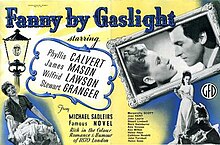Fanny by Gaslight (film)
| Fanny by Gaslight | |
|---|---|
 UK promotional poster | |
| Directed by | Anthony Asquith |
| Written by | Doreen Montgomery additional dialogue Aimée Stuart |
| Produced by | Edward Black |
| Starring | Phyllis Calvert James Mason Wilfrid Lawson Stewart Granger |
| Cinematography | Jack E. Cox |
| Edited by | R. E. Dearing |
| Music by | Cedric Mallabey |
Production company | |
Release dates | May 1944 (UK) 1946 (France) 1948 (USA) |
Running time | 107 minutes |
| Country | United Kingdom |
| Language | English |
| Budget | £90,000[1] |
| Box office | $17,285 (US rentals)[2] over ₤300,000 (UK)[3] 786,581 admissions (France)[4] |
Fanny by Gaslight (US title – Man of Evil) is a 1944 British drama film, produced by Gainsborough Pictures, set in the 1870s and adapted from a novel by Michael Sadleir (also adapted as a 1981 mini-series).
It was the second of its famous period-set "Gainsborough melodramas", following The Man in Grey (1943). Its US release was delayed for its breaking the Hays Purity Code, and 17 minutes were removed for this release.
Stewart Granger later said he "didn't like" the film because of its "drippy characters" but thought "Asquith was much the best of those directors I worked with at Gainsborough."[5]
Plot
Fanny (Phyllis Calvert) finishes at boarding school in 1880 and returns to London, where she witnesses Lord Manderstoke (James Mason) fight and kill her supposed father. She soon learns that her family has run a brothel next door to her home and (on her mother's death) that he was not her real father. She goes to meet her real father – a respected politician – and falls in love with Harry Somerford (Stewart Granger), his advisor. Manderstoke continues to thwart her happiness.
Cast
- Phyllis Calvert as Fanny Hooper
- James Mason as Lord Manderstoke
- Wilfrid Lawson as Chunks
- Stewart Granger as Harry Somerford
- Jean Kent as Lucy Beckett
- Margaretta Scott as Alicia
- Nora Swinburne as Mrs. Hopwood
- Cathleen Nesbitt as Kate Somerford
- Helen Haye as Mrs. Somerford
- John Laurie as William Hopwood
- Stuart Lindsell as Clive Seymoure
- Amy Veness as Mrs. Heaviside
- Ann Wilton as Carver
- Guy Le Feuvre as Doctor Lowenthal
- Esma Cannon as Gossping maid Uncredited and Shelagh Fraser also a maid not mentioned.
- Ann Stephens as Fanny as a child
- Gloria Sydney as Lucy as a child
- John Turnbull as Magistrate
- Cyril Smith as Publican
- Helen Goss as Polly
- Johnnie Schofield as Joe
- Vi Kaley as Joe's wife
- Peter Jones as New client at The Shades
Production
The film was based on a novel published in 1940.[6][7]
Phyllis Calvert and Anthony Asquith were attached to the project by October 1942.[8]
Reception
It was the second most popular film in Britain during 1944, after This Happy Breed.[9] However, it performed very badly at the box office in the US.[2]
References
- ^ Realism and Tinsel: Cinema and Society in Britain 1939-48 By Robert Murphy p 55
- ^ a b Geoffrey Macnab, J. Arthur Rank and the British Film Industry, London, Routledge (1993) p164
- ^ "Actor's Views May Bring Ban". The Sydney Morning Herald. National Library of Australia. 13 September 1945. p. 2. Retrieved 4 March 2013.
- ^ Box office information for Stewart Granger films in France at Box Office Story
- ^ Brian MacFarlane, An Autobiography of British Cinema, Methuen 1997 p 230
- ^ LIGHTS, SHADES, AND LADIES: A LOVE STORY IN OLD LONDON Brown, Ivor. The Observer (1901- 2003); London (UK) [London (UK)]05 May 1940: 4.
- ^ "HOLLYWOOD LETTER". The Advocate (Australia). Tasmania, Australia. 27 September 1946. p. 9. Retrieved 10 October 2018 – via National Library of Australia.
- ^ "Round the British studios". The Australian Women's Weekly. Vol. 10, , no. 21. Australia, Australia. 24 October 1942. p. 10 (The Movie World). Retrieved 10 October 2018 – via National Library of Australia.
{{cite news}}: CS1 maint: extra punctuation (link) - ^ Reeves p.180
Bibliography
- MacFarlane, B. (1997) An Autobiography of British Cinema, Methuen. ISBN 0413726703.
- Reeves, N. (2003) The power of film propaganda: myth or reality?, Continuum: London. ISBN 9780826473905.
External links
- Fanny by Gaslight at IMDb
- Fanny by Gaslight at TCMDB
- Fanny By Gaslight at BFI Screenonline
- Review of film at Variety
- 1944 films
- British films
- British black-and-white films
- English-language films
- Melodramas
- Gainsborough Pictures films
- Films based on British novels
- Films set in the 1850s
- Films set in the 1860s
- Films set in the 1870s
- Films set in 1880
- Films set in Paris
- Films set in London
- British historical films
- 1940s historical films
- Films directed by Anthony Asquith
